|
Lincolnshire Windmills, May 2019
Ruth Andrews
|
|
HMG’s recent study tour to Lincolnshire managed to
visit 4 outwardly quite similar windmills in 3
days. This was really interesting experience, as it
enabled us to compare the different strategies
employed to attract funding and visitors. The mills
shared similar fortunes and misfortunes which
allowed these giants of their type to avoid the
usual fate of dereliction and house conversion. |
|
Moulton Windmill:
At 9 storeys and 100ft to the top of its ogee cap,
this is the tallest mill we visited. It was built
in 1822 with a large adjacent granary and it is
grade 1 listed. It has 4 double-sided patent sails,
a fantail, and a reefing stage. The sails were
removed after gale damage in 1894, at which time a
steam mill with a 2-sack Turner roller mill was
installed in the granary. Inevitably the mill fell
into disrepair.
In 2003 the mill featured in the first series of
BBC2’s Restoration programme. It won a large
HLF grant, and the Friends of Moulton Mill were able
to restore and refurbish the mill’s structure and
add a new cap. The fan stage and the sails were
restored in 2011.
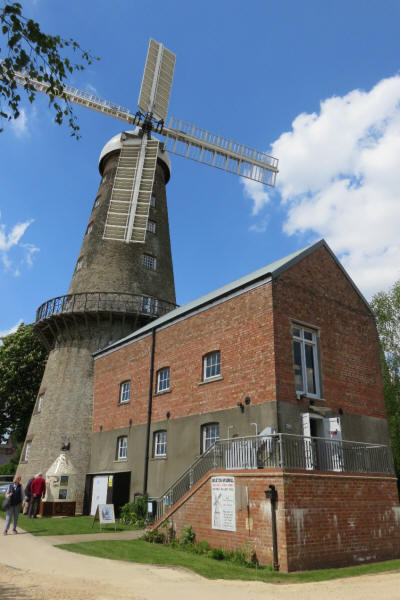
The basement contains engine driven gearing which
then ascends to a set of stones on the first floor.
Note the unusual stones furniture. The roller mill
seems to have vanished without trace.
|
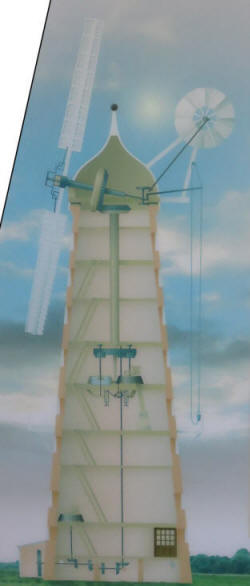
The mill contains a good explanatory diagram but it
does highlight just how much ancillary machinery has
not survived.

|
|
Heckington Windmill:
This was built in 1830 as a 5-sailed windmill, but
it was destroyed in a severe thunderstorm and then
repaired in 1892 using a cap and 8 sails from
Skirbeck Windmill in Boston, dating from 1813. Some
of the Skirbeck bricks were also used for the
adjacent mill house. The mill ceased working in
1846 and was acquired by Kesteven County Council in
1953, being restored in 1986 and 2004. It is now
owned by Lincolnshire County Council and run by
Heckington Windmill Trust volunteers. The mill
shares its site with an award-winning micro-brewery,
which attracts more customers than the mill.
Wholemeal flour is at present being produced on a
pair of free-standing Derbyshire gritstones, mounted
on a hurst frame by H Onyon of Sleaford, and powered
by a Ruston & Hornsby oil engine housed in an
adjacent cart shed (below right).
|
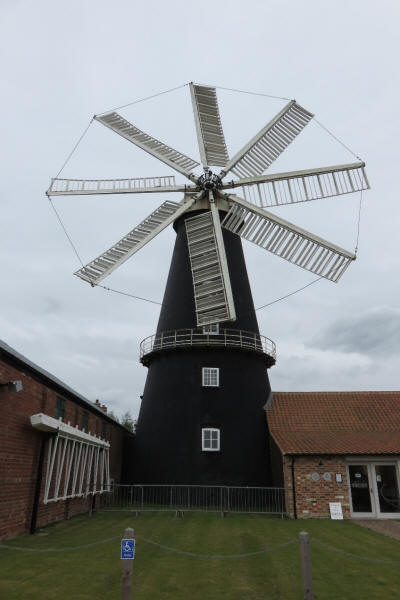 |
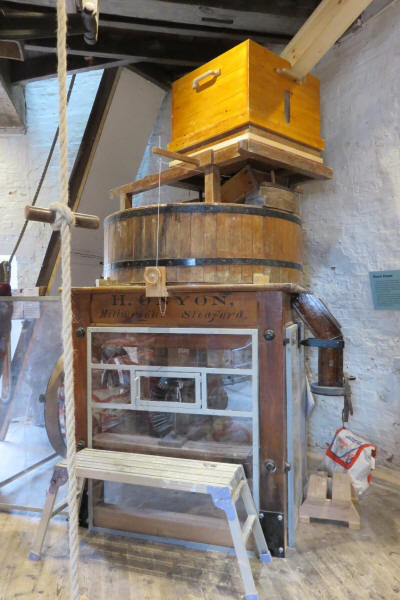 |
|
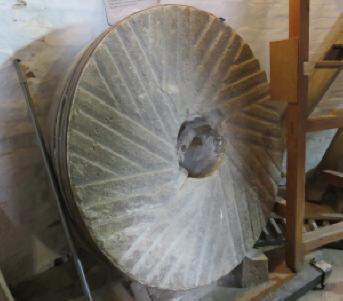 |
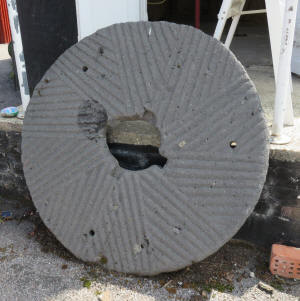 |
|
The millstone on the left at Heckington is made from
a single piece of French burr. On the right is a
grey stone of black lava from Mayen near Cologne,
hence the alternative name ‘cullen’ or blue stone.
It is dressed to run anti-clockwise and comes from
Dobson Windmill, which is unusual because its sails
rotate clockwise.
|
|
Dobson Windmill, Burgh-le-Marsh:
This grade 1 listed 5-storey windmill was probably
built in 1813, although the mill tower was not
completed until 1844. It worked commercially until
1964. It is unusual because its 5 single-sided
patent sails rotate clockwise, driving 2 pairs of
grey stones and one pair of French burrs. The mill
was purchased by the local council in the 1960s and
refurbished with a new cap and sails in 2014. It is
now run by Burgh-le-Marsh Heritage Group, which also
has a small and interesting heritage museum in some
of the ancillary buildings. This is the only mill
of the four that doesn’t have a reefing stage. |
 |
|
Maud Foster Windmill, Boston:
Picturesquely situated by the River Witham in the
middle of the town, it was built in 1819 and has 5
single-sided patent sails. The adjacent granary and
bakehouse was built in 1820, and later a steam
engine to power a bone mill was added, but the
business failed in 1833. From 1914 to 1948 it ran
successfully until the windmill became inoperable.
It was finally rescued in 1987 by the present owners
who had totally repaired it by 1998. This is the
only commercially operating windmill that we
visited. Perhaps fortunately there was not enough
wind for milling so we were able to look round.
Everything was covered in flour as seen below right
on this Stamford Stone Mill – and the ‘Henry’ next
to it.
|
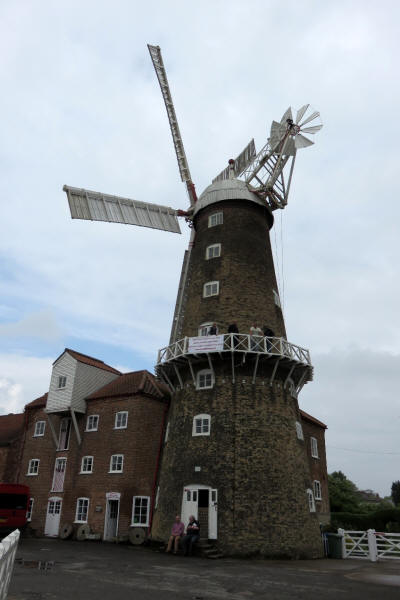 |
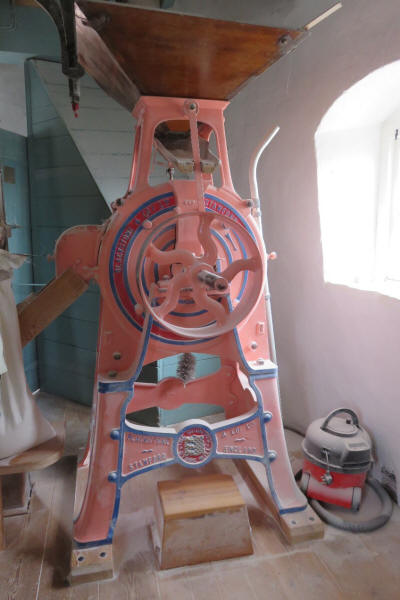
|
|
All the mills we visited had stones which were
overdrift (driven from above) via a square quant
(stone spindle). These photos taken at Maud Foster
show that instead of using a damsel grain was
scattered into the eye of the stone by a small piece
of wood mounted on the shoe which rubbed against the
quant as it rotated. In the photo on the left this
piece of wood has recently been turned round and the
worn surface can be seen on the right. |
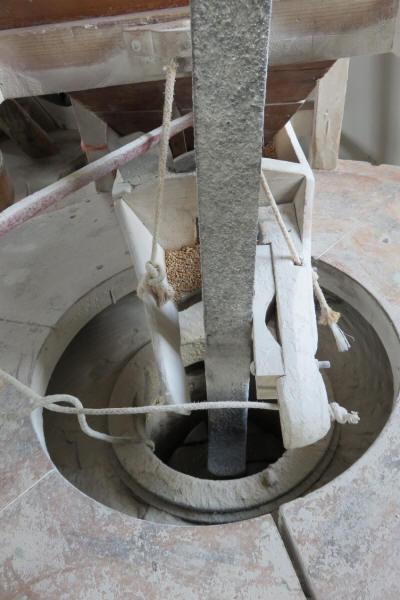 |
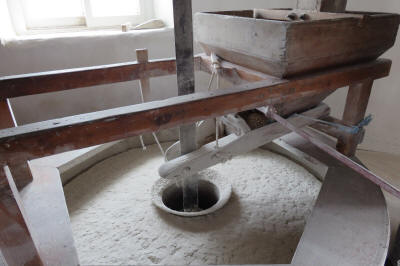
This gives a possible explanation as to why the mill
was full of flour: the tuns do not completely
enclose the stones. |
